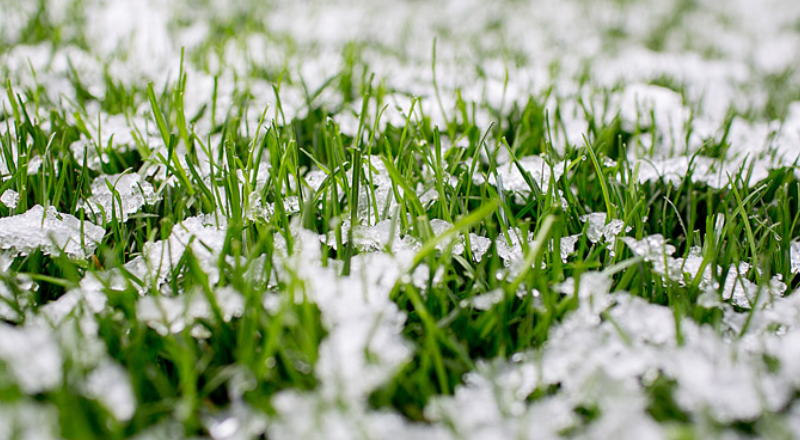
10
Dec
As the temperatures drop and the days get shorter, it’s time to start preparing your lawn for the harsh winter months ahead. While your lawn may seem to go into dormancy, proper winter care can make a huge difference in how it looks when spring arrives. A little attention now will ensure your grass stays healthy and vibrant when warmer weather returns.
Here are essential tips to help you prepare your lawn for winter:
1. Clean Up Leaves and Debris
Fallen leaves and yard debris can create a thick mat over your lawn, blocking sunlight and airflow. If left unchecked, this can cause the grass to suffocate, leading to mold growth and damage to the turf.
Action Steps:
- Rake regularly: Keep your lawn free from leaves and branches.
- Use a leaf blower or mower: If you have large areas, a leaf blower can save time, or you can mow the lawn with a mulching blade to chop up the leaves and leave a layer of mulch that will decompose over the winter.
Why it works: Removing debris ensures that your grass has access to sunlight and air, which is essential for its health during dormancy.
2. Aerate Your Lawn
Lawn aeration involves perforating the soil with holes to allow water, nutrients, and air to reach the grass roots more easily. If your lawn is compacted, winter conditions will make it even harder for the grass to grow back in the spring.
Action Steps:
- Aerate the lawn: If your lawn sees heavy foot traffic, aeration is essential. You can rent an aerator from a local garden center or hire a professional.
- Timing: Aim to aerate your lawn a few weeks before the first freeze to give the grass time to recover.
Why it works: Aeration helps the soil breathe and improves root growth, ensuring your lawn comes back strong in the spring.
3. Fertilize Your Lawn for Winter Hardiness
Applying the right type of fertilizer in the fall can give your lawn the nutrients it needs to survive the winter and bounce back in the spring. Fertilizers rich in potassium and phosphorus will promote root growth and winter hardiness, while avoiding too much nitrogen, which can encourage unhealthy growth.
Action Steps:
- Use a fall-specific fertilizer: Choose a fertilizer that’s specifically designed for winter preparation, with a higher ratio of potassium and phosphorus.
- Apply before the first frost: Fertilizer should be applied about 2-4 weeks before the ground freezes to give it time to absorb.
Why it works: Proper fertilization strengthens the roots, making the grass more resilient to cold temperatures and ensuring it comes back greener in the spring.
4. Seed Bare Patches and Reseed Thin Areas
If your lawn has bare spots or thinning grass, fall is the best time to reseed. The cool temperatures and consistent rainfall of autumn create ideal conditions for grass seeds to germinate and establish before winter sets in.
Action Steps:
- Seed the bare spots: Use a high-quality grass seed that is suited to your climate and soil type.
- Water gently: Water the newly seeded areas regularly, but avoid over-watering, as the cooler weather will reduce the need for excessive moisture.
Why it works: Reseeding helps to fill in gaps, ensuring a full, healthy lawn come springtime. The cooler temperatures allow the seeds to establish without the stress of summer heat.
5. Mow Your Lawn to the Right Height
As fall comes to an end, it’s important to adjust your mowing routine. Cutting your grass too short before winter can damage the lawn, while leaving it too long can lead to problems with mold and pests.
Action Steps:
- Set your mower blade higher: Mow your lawn one last time in late fall, but set the blade to about 2.5–3 inches. This allows the grass to grow long enough to protect the roots over winter without becoming too long and prone to disease.
- Don’t mow too late: Stop mowing your lawn when the grass stops growing due to cold weather.
Why it works: Proper mowing height helps to protect the grass from extreme cold, while keeping it short enough to avoid suffocating under the weight of snow or leaves.
6. Water Before the Ground Freezes
While your lawn’s water needs decrease as the temperatures drop, it’s important to give it a final deep watering before the ground freezes. This will help the roots absorb moisture, which is vital for their survival during the winter months.
Action Steps:
- Water deeply in fall: Water your lawn thoroughly, but ensure the water soaks in deeply to reach the roots.
- Stop watering once temperatures drop: When the temperatures drop consistently below freezing, stop watering to prevent frost damage.
Why it works: Proper watering ensures your lawn retains enough moisture to survive during the colder months when it’s unable to absorb moisture from the soil.
Conclusion: Winterize Your Lawn for a Healthier Spring
By following these simple tips, you can prepare your lawn for the winter months and ensure it comes back healthy and vibrant in the spring. From cleaning up debris to aerating and fertilizing, these steps will help your lawn survive the cold season and thrive when the weather warms up.
If you need help with preparing your lawn for winter, or if you want to ensure your yard stays in top condition year-round, contact Warsanal Madeena. Our expert team offers professional lawn care services that include everything from aeration to fertilization, helping you achieve the perfect lawn in every season.

Leave A Comment